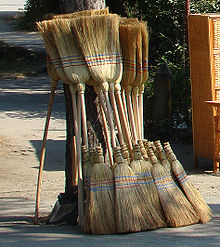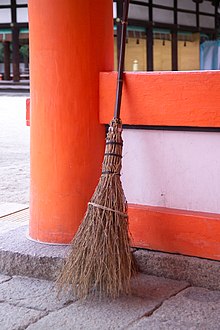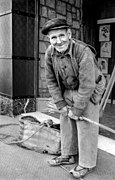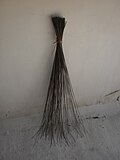Broom
The broom is a tool that consists of a stick or rod to which hard fibers or a brush are fixed at the end and used to sweep or clean dirt from the floor.
A distinction is made between a "stiff broom" and a "soft broom" and an intermediate spectrum. Soft brooms are used in some cultures primarily for sweeping walls of cobwebs and spiders, much like a 'duster', while hard brooms are for rougher tasks, such as sweeping dirt from sidewalks or floors. of concrete, or even smooth and texture wet concrete. Most brooms fall somewhere in between, suitable for sweeping floors in homes and businesses, soft enough to be flexible to move even light dust, yet stiff enough for a steady sweeping action.
History
Brooms have undergone significant changes in their construction, since they were developed from a bunch of branches or different natural or synthetic fibers tied to a stick at one end
The fibers used in modern brooms are obtained from a corn-like plant called sorghum broom (in Chile it is called “curagüilla”). They are long, straight and durable.
The most recent major change is the flat broom, invented by the Shakers in the early 19th century. This broom It has more width to better push the dirt. At present, almost all the brooms that are built are flat, the round broom having become practically obsolete.
Manufacturing
In 1797, the quality of brooms changed when Levi Dickenson, a farmer in Hadley, Massachusetts, made a broom for his wife, using the tassels of sorghum, a grain he grew for seed. Her wife told her friends in town about the benefits of her broom, creating a demand for Dickenson's sorghum brooms. The sorghum brooms held up well, but eventually, like all brooms, they fell apart. Dickenson subsequently invented a machine that would make better brooms and faster than he did. In 1810, the treadle broom machine was invented. This machine played an integral role in the Industrial Revolution.
United States
One source mentions that the United States had 303 broom factories in 1839 and that the number peaked at 1,039 in 1919. Most of these were in the eastern United States; during the Great Depression of the 1930s, the number of factories dwindled to 320 by 1939. The state of Oklahoma became a major center of broom production because broom corn grew especially well there, and The Oklahoma Broom Corn Company opened a factory in El Reno in 1906. Faced with competition from imported brooms and synthetic bristles, most factories closed in the 1960s.
In literature
Since ancient times, it has been a tradition to associate witches with broomsticks, which would give them the power to fly, and by the way, this belief has been widely reflected in literature, movies and television.
In many children's stories brooms appear as important elements in the plots of the stories; such is the case of the work Cinderella, whose main character has even been called "Queen Broom".
Cinderella, Gretel (Hansel's little sister), and Snow White have all traditionally been associated with the broom. By sweeping the floor two of them got a husband, and the third saved her life. As can be seen, the broom and household chores have traditionally been associated with female characters.
The broom can also be seen in the Venezuelan children's story La Cucarachita Martínez by Antonio Arráiz. In this case, the character sweeping found a "mediecito" (currency equivalent to 25 bolivar cents).
Gallery
Contenido relacionado
Roa (disambiguation)
Ine
Template:UKR















